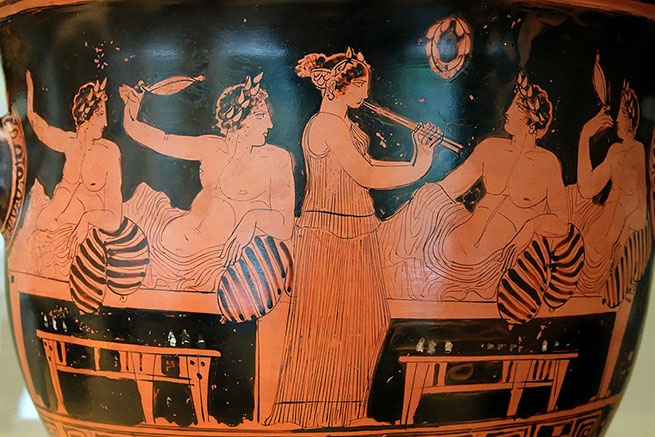
Культура Греции формировалась на протяжении многих тысяч лет. Греческий язык – один из древнейших языков мира. Он существует уже более 4 000 лет, а письменность - 3 000 лет. Предлагаем вашему вниманию список наиболее известных древнегреческих писателей и поэтесс.
Из огромного множества произведений древнегреческой литературы до нас дошли лишь весьма немногие; немало писателей и их сочинений известны нам только по именам; почти нет ни одного древнегреческого писателя, от которого дошло бы к нам все его литературное достояние. Ко всему этому присоединяется порча первоначальных текстов по вине времени, по невежеству переписчиков и иным обстоятельствам. Понятно, почему до настоящего времени не существует такого обозрения Греческой литературы, которое изображало бы все последовательное её развитие, без пробелов или произвольных теоретических построений. Однако вековыми усилиями учёных достигнуто многое в смысле восстановления древних текстов и разностороннего выяснения литературных произведений.
Отличавшая древнего эллина способность живо воспринимать окружающее и быстро отзываться на него, проникать глубоко в основные мотивы явлений и улавливать их типические, существенные черты, пластичность греч. речи, позволявшая эллину выражать легко и точно каждую свою мысль и настроение со всеми их оттенками, сообщили древнегреческой литературе гуманистический характер и обеспечили за нею общечеловеческий интерес. В основных свойствах эллинского гения кроется разгадка несравненной оригинальности его научного и художественного творчества, долговечности множества выработанных им идей, образов и целых систем мировоззрения; этим же обусловливается то громадное влияние, какое имела древнеэллинская литература на все позднейшие, начиная с римской, и на европейскую образованность вообще.
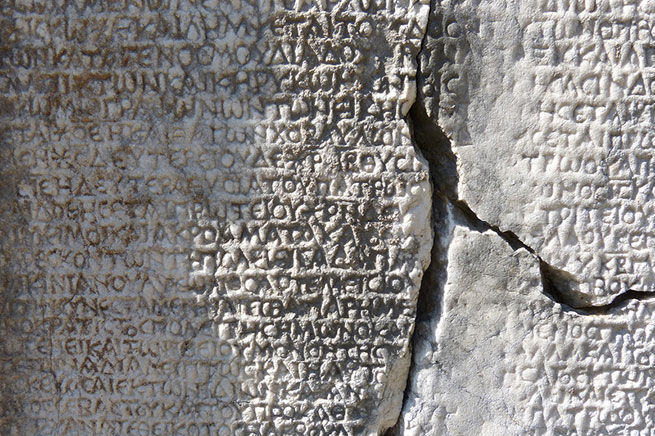
Всестороннему развитию природных дарований благоприятствовали особенности политического общежития, поощрявшие высокое напряжение умственных сил и допускавшие широкую свободу мысли и слова. Успехи драмы, красноречия и изучения форм политического общежития находились в ближайшей зависимости от демократического строя городских республик. Вовсе не случайно то обстоятельство, что по степени и качеству умственной производительности в древней Греции первое место принадлежало афинской демократии, где и политические учреждения, и нравы, и вкусы общества наиболее содействовали свободному развитию и упражнению всех способностей гражданина, потребных для деятельного сознательного участия в делах общины.
Крайними пределами истории древнегреческой литературы следует признавать XI в. до н. э., когда сложились многочисленные сказания о героях Троянской войны, и первую половину VI в. н. э., когда по распоряжению императора Юстиниана (529) были закрыты философские школы в Афинах.
В этом промежутке времени различаются два отдела:
- один — от начала литературы до III в. до н. э., по преимуществу творческий;
- другой — от начала александрийской учёности до Юстиниана, по преимуществу время изучения прежней литературы и усвоения древнегреческой образованности другими народностями.
В творческой эпохе Г. литературы различаются два периода:
- развитие эпоса, лирики, возникновение драмы и всех видов прозы — приблизительно до 480 г. до н. э.,
- другой период, аттический, пора высшего процветания драмы, красноречия, философии, историографии с переходом к точным наукам.
В первом периоде руководящая роль принадлежала колониям, во втором неоспоримо господствовали Афины.
Сейчас мы познакомимся с девятью наиболее влиятельными античными писателями и одной поэтессой. Есть нечто, что их объединяет, - речь идет о том влиянии на современную культуру и общество, которое они оказали. Пройдемся в порядке хронологии.
1. Гомер
(VIII-ой век до н.э.)
(VIII-ой век до н.э.)
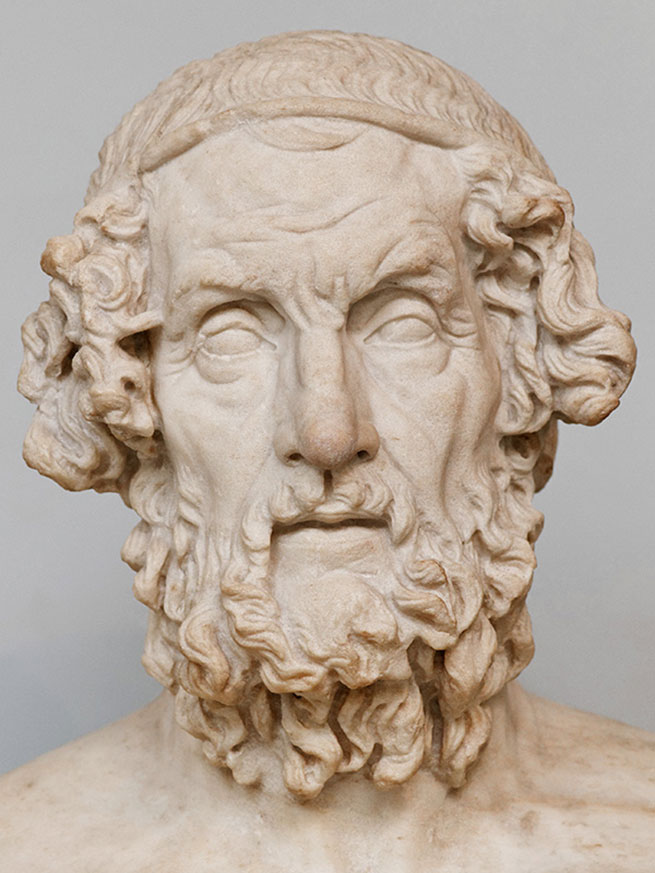
Гомер
Гоме́р (др.-греч. Ὅμηρος, VIII век до н. э.) — легендарный древнегреческий поэт-сказитель, создатель эпических поэм «Илиада» (древнейшего памятника европейской литературы) и «Одиссея». Примерно половина найденных древнегреческих литературных папирусов — отрывки из Гомера.
Ясно, однако, что «Илиада» и «Одиссея» были созданы значительно позже описываемых в них событий, но раньше VI века до н. э., когда достоверно зафиксировано их существование. Хронологический период, в котором локализует жизнь Гомера современная наука, — приблизительно VIII век до н. э. По словам Геродота, Гомер жил за 400 лет до него, что указывает на дату 850 лет до н. э. Неизвестный историк в своих записках указывает, что Гомер жил за 622 года до Ксеркса, что указывает на 1102 год до н. э. Другие древние источники говорят, что он жил во времена Троянской войны. На данный момент существует несколько дат рождения и доказательств к ним.
Даже сами греки признают влиятельность Гомера и не считают достаточно образованными тех своих соотечественников, кто не читал его произведений. При этом до сих пор ведутся споры относительно того, является ли Гомер реальной исторической фигурой. О нем и его жизни неизвестно абсолютно ничего. Произведения «Илиада», и «Одиссея» внесли огромный вклад в литературу. Фактически даже Шекспир написал одну из своих пьес на основе «Илиады».
Ясно, однако, что «Илиада» и «Одиссея» были созданы значительно позже описываемых в них событий, но раньше VI века до н. э., когда достоверно зафиксировано их существование. Хронологический период, в котором локализует жизнь Гомера современная наука, — приблизительно VIII век до н. э. По словам Геродота, Гомер жил за 400 лет до него, что указывает на дату 850 лет до н. э. Неизвестный историк в своих записках указывает, что Гомер жил за 622 года до Ксеркса, что указывает на 1102 год до н. э. Другие древние источники говорят, что он жил во времена Троянской войны. На данный момент существует несколько дат рождения и доказательств к ним.
Даже сами греки признают влиятельность Гомера и не считают достаточно образованными тех своих соотечественников, кто не читал его произведений. При этом до сих пор ведутся споры относительно того, является ли Гомер реальной исторической фигурой. О нем и его жизни неизвестно абсолютно ничего. Произведения «Илиада», и «Одиссея» внесли огромный вклад в литературу. Фактически даже Шекспир написал одну из своих пьес на основе «Илиады».
2. Сапфо
(630/612 — 572/570 до н. э.)
(630/612 — 572/570 до н. э.)
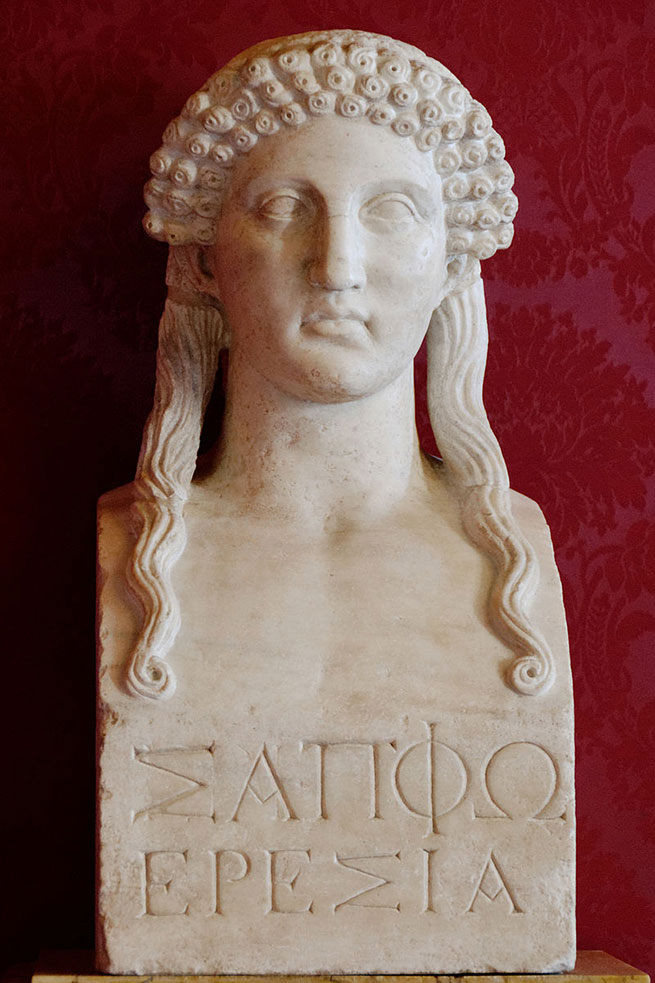
Сапфо
Сапфо́ (тж. Сафо́, Са́фо, Сафо Митиленская; аттич. др.-греч. Σαπφώ (произносится — /sapːʰɔː/), эолийск. др.-греч. Ψάπφω (произносится — /psapːʰɔː/); около 630 года до н. э., о-в Лесбос — 572/570 до н. э.) — древнегреческая поэтесса и музыкант, автор монодической мелики (песенной лирики). Была включена в канонический список Девяти лириков. «Сапфо фиалкокудрая, сладкоулыбающаяся, чистая…», — писал о ней её друг поэт Алкей.
Биографические данные Сапфо скудны и разноречивы. Она родилась на острове Лесбос в Митилене. Её отец Скамандроним был «новым» аристократом; будучи представителем знатного рода, он занимался торговлей. Её мать звали Клеидой. Помимо Сапфо у них было трое сыновей. Чувство слова и ритма обнаружилось у Сапфо в раннем возрасте, и, по-видимому, уже с ранних лет она писала гимны для хора, выступавшего на Термийских панегиреях — главном религиозном празднестве Митилены, которое было посвящено Артемиде Термии, древней богине, хозяйке водных источников на о. Лесбос. Помимо гимнов для хора Сапфо писала оды, гимны, элегии, праздничные и застольные песни. См. об этом в детальном исследовании Т. Г. Мякина.
Биографические данные Сапфо скудны и разноречивы. Она родилась на острове Лесбос в Митилене. Её отец Скамандроним был «новым» аристократом; будучи представителем знатного рода, он занимался торговлей. Её мать звали Клеидой. Помимо Сапфо у них было трое сыновей. Чувство слова и ритма обнаружилось у Сапфо в раннем возрасте, и, по-видимому, уже с ранних лет она писала гимны для хора, выступавшего на Термийских панегиреях — главном религиозном празднестве Митилены, которое было посвящено Артемиде Термии, древней богине, хозяйке водных источников на о. Лесбос. Помимо гимнов для хора Сапфо писала оды, гимны, элегии, праздничные и застольные песни. См. об этом в детальном исследовании Т. Г. Мякина.
3. Софокл
(496-406 гг. до н. э.)
(496-406 гг. до н. э.)
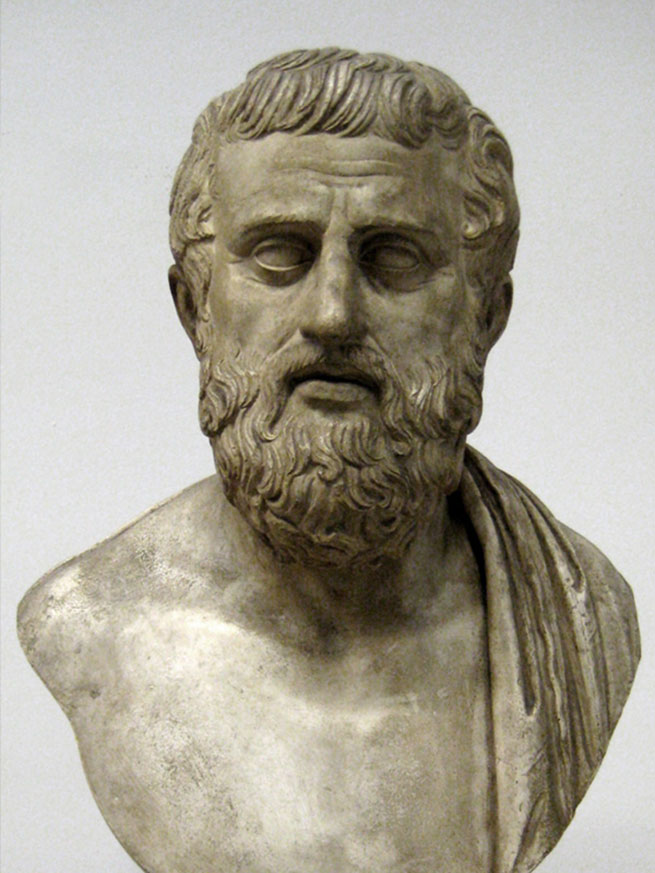
Софокл
Софо́кл (др.-греч. Σοφοκλῆς, 496/5 — 406 до н. э.) — афинский драматург, трагик.
Родился в 495 году до н. э., в афинском предместье Колон. Место своего рождения, издавна прославленное святынями и алтарями Посейдона, Афины, Евменид, Деметры, Прометея, поэт воспел в трагедии «Эдип в Колоне». Происходил из обеспеченной семьи Софилла, получил хорошее образование.
После Саламинской битвы (480 год до н. э.) участвовал в народном празднике как руководитель хора. Дважды был избран на должность стратега и один раз исполнял обязанности члена коллегии, ведавшей союзной казной. Афиняне выбрали Софокла в стратеги в 440 году до н. э. во время Самосской войны под впечатлением его трагедии «Антигона», постановка которой на сцену относится, таким образом, к 441 году до н. э.
Главным его занятием было составление трагедий для афинского театра. Первая тетралогия, поставленная Софоклом в 469 году до н. э., доставила ему победу над Эсхилом и открыла собой ряд побед, одержанных на сцене в состязаниях с другими трагиками. Критик Аристофан Византийский приписывал Софоклу 123 трагедии (в том числе и Антигона). Из рукописей уцелели лишь семь, но они стали настоящей классикой. Речь идет о таких произведениях, как «Антигона», «Царь Эдип» и «Электра». Он развивал театральное искусство путем добавления массовки, сокращения важности хора и введения сценографии. Софокл также упразднил традицию ставить трагедии в форме трилогии. Он сделал так, чтобы каждая постановка была самостоятельной, что увеличивало их драматизм.
Софокл отличался весёлым, общительным характером, не чуждался радостей жизни, как видно из слов некоего Кефала в Платоновом «Государстве» (I, 3). Был близко знаком с историком Геродотом. Умер Софокл на 90-м году жизни, в 405 году до н. э. в городе Афины. Горожане соорудили ему жертвенник и ежегодно чествовали как героя.
4. Геродот
(484-425 гг. до н. э.)
(484-425 гг. до н. э.)
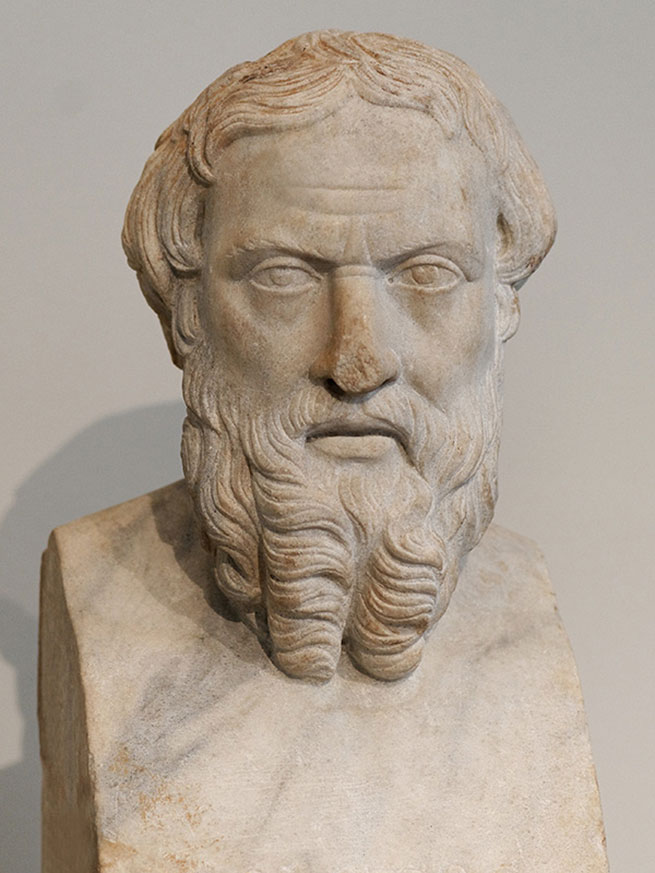
Геродот
Геродо́т Галикарна́сский (др.-греч. Ἡρόδοτος Ἁλικαρνᾱσσεύς, около 484 г до н. э. — около 425 г до н. э.) — древнегреческий историк, по крылатому выражению Цицерона «отец истории» — автор первого[1] сохранившегося значительного трактата «История», описывающего греко-персидские войны и обычаи многих современных ему народов. Труды Геродота имели огромное значение для античной культуры.
Геродот признан отцом истории Западной культуры. Он приблизил историю к науке, систематически собирая и упорядочивая материалы, а также проверяя их соответствие действительности. Геродот также был талантливым рассказчиком. Сама по себе история слова истоками уходит к книге Геродота «История» (а «история» в переводе с греческого языка означает «расспрашивание»). Эта книга также признана первым историческим произведением в Западной культуре.
5. Еврипид
(480-406 до н. э.)
(480-406 до н. э.)
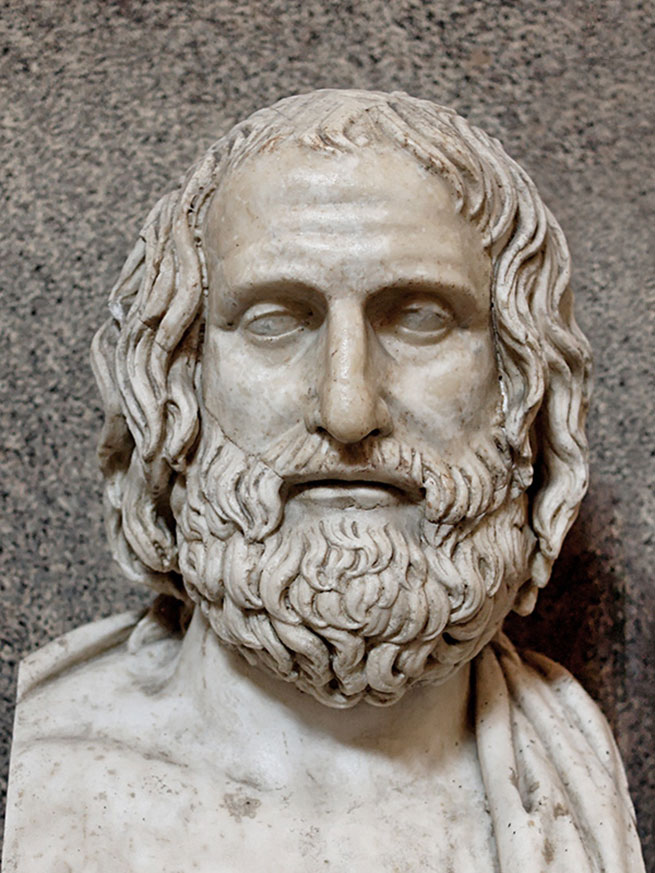
Еврипид
Еврипи́д (правильнее Эврипи́д, др.-греч. Εὐριπίδης, лат. Euripides, 480-е — 406 до н. э.) — древнегреческий драматург, крупнейший (наряду с Эсхилом и Софоклом) представитель классической афинской трагедии. Написал около 90 драм, из которых до нас дошло 17 трагедий и сатировская драма «Киклоп», а большинство уцелело лишь фрагментарно. Его самые известные произведения - «Алкеста», «Медея» и «Вакханки». Его пьесы для своего времени казались слишком современными, персонажи в них изображались очень реалистично, и среди них можно было увидеть сильных женщин и мудрых рабов, что для того времени было несвойственно и считалось отступлением от традиций. Еврипид - греческий трагик, оказавший огромное влияние на европейскую трагедию в целом.
6. Гиппократ
(460-370 гг. до н. э.)
(460-370 гг. до н. э.)
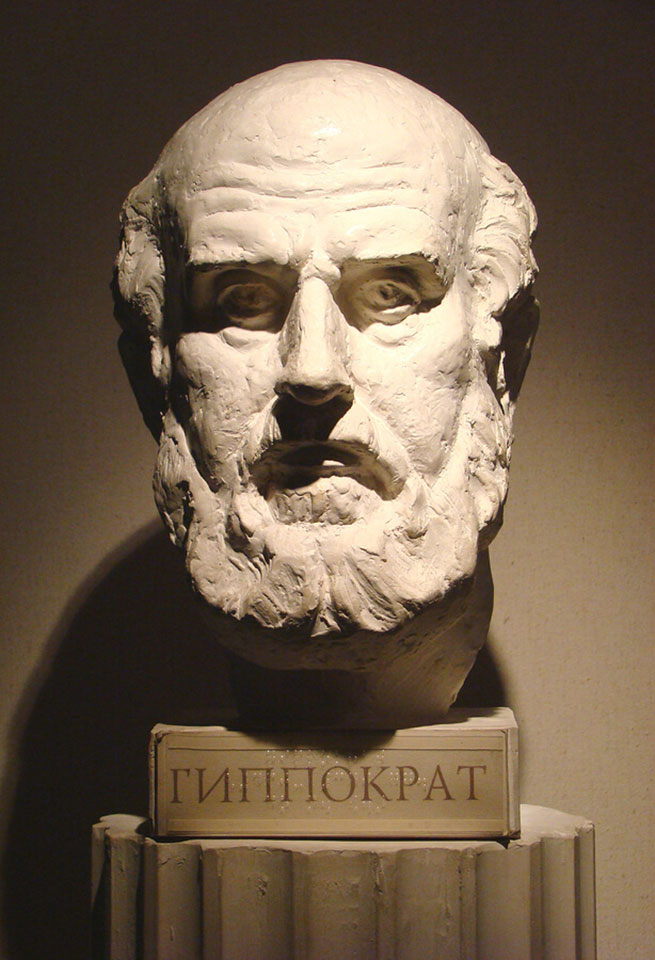
Гиппократ
Гиппократ был врачом и отцом всей медицины. Гиппократовский корпус - коллекция размышлений на различные медицинские темы - насчитывает 70 работ. Значительная их часть основана на случаях из практики. Самая известная работа Гиппократа - «Клятва», рассказывающая о врачебной этике. Производные положения этой клятвы и по сей день принимаются врачами всего мира. Непосредственный вклад Гиппократа в медицину состоит также в описании огромного количества заболеваний. До сих пор подвергается сомнению тот факт, был ли сам Гиппократ автором Гиппократовского корпуса. Многие склоняются к точке зрения, что как минимум несколько его частей были написаны учениками и последователями великого медика.
7. Аристофан
(446 - 386 гг. до н. э.)
(446 - 386 гг. до н. э.)
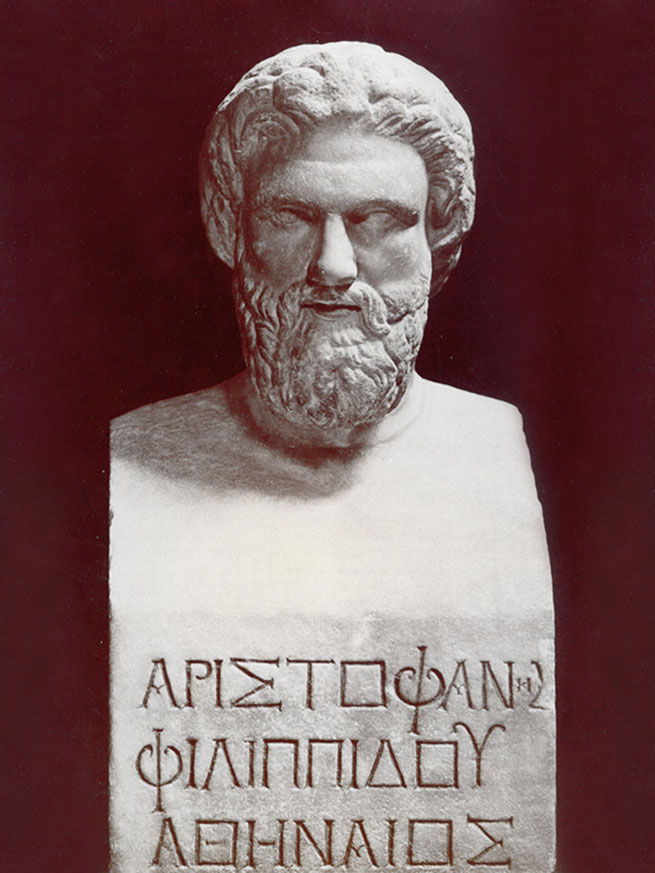
Аристофан
Аристофа́н (др.-греч. Ἀριστοφάνης) (444 до н. э. — между 387 и 380 гг., Афины) — древнегреческий комедиограф, прозванный «отцом комедии». Первую свою комедию Аристофан поставил в 427 г до н.э , но ещё под чужим именем. Когда год спустя (426) он осмеял в своих «Вавилонянах» могущественного демагога Клеона, назвав кожевником, последний обвинил его перед советом в том, что он в присутствии уполномоченных от союзных государств порицал и выставил в смешном виде политику Афин. Позднее Клеон поднял против него довольно обычное в Афинах обвинение в незаконном присвоении звания афинского гражданина. Аристофан, как говорят, защищался перед судом стихами Гомера:
«Мать уверяет, что сын я ему, но сам я не знаю:
Ведать о том, кто отец наш, наверное, нам невозможно».
Аристофан отомстил Клеону, жестоко напав на него в комедии «Всадники». Влияние этого демагога было столь велико, что никто не согласился делать маску для Пафлагонца, напоминающую Клеона, а образ Пафлагонца был рисован настолько отталкивающим, что эту роль вынужден был играть сам Аристофан. Нападки на Клеона появляются и в последующих комедиях. Вот почти всё, что известно о жизни Аристофана; древние называли его попросту Комиком, подобно тому, как Гомер был известен у них под именем Поэта.
«Мать уверяет, что сын я ему, но сам я не знаю:
Ведать о том, кто отец наш, наверное, нам невозможно».
Аристофан отомстил Клеону, жестоко напав на него в комедии «Всадники». Влияние этого демагога было столь велико, что никто не согласился делать маску для Пафлагонца, напоминающую Клеона, а образ Пафлагонца был рисован настолько отталкивающим, что эту роль вынужден был играть сам Аристофан. Нападки на Клеона появляются и в последующих комедиях. Вот почти всё, что известно о жизни Аристофана; древние называли его попросту Комиком, подобно тому, как Гомер был известен у них под именем Поэта.
Аристофан написал 40 пьес, 11 из которых дошли до наших дней в виде законченных рукописей, а от других остались лишь фрагменты. Пера Аристофана боялись, поскольку он мог высмеять и обидеть знаменитых афинян. Платон обратил внимание на его пьесу «Облака», которая выступала ключевым аргументом в суде над Сократом. Однако так ли это было на самом деле - вопрос спорный. Другие примечательные работы, вышедшие из-под его руки, - «Осы» и «Лисистрата». Работы Аристофана не только оказали художественное влияние на дальнейшее развитие театра, но и стали подлинными историческими свидетельствами жизни в Афинах.
8. Платон
(424-348 гг. до н. э.)
(424-348 гг. до н. э.)
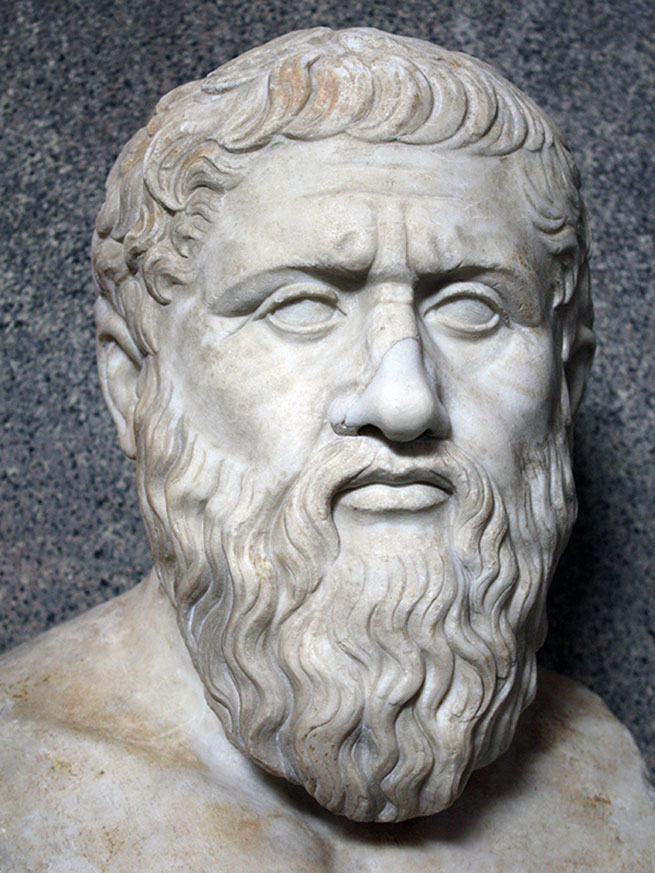
Платон
Плато́н (др.-греч. Πλάτων, 428 или 427 до н. э., Афины — 348 или 347 до н. э., там же) — древнегреческий философ, ученик Сократа, учитель Аристотеля. Платон — первый философ, чьи сочинения сохранились не в кратких отрывках, цитируемых другими, а полностью.
Поскольку сам Сократ после себя никаких письменных трудов не оставил, его философские идеи мы узнаем в основном из работ Платона. Не меньше, чем сам образ мысли Сократа, на Платона сильно повлиял суд над ним, в котором последний выступил свидетелем, когда ему было 29 лет. Платону приписывается авторство 35 диалогов и 13 писем, самыми известными из которых являются «Государство» и «Пир». Платона почитают как одного из отцов западной философии, а его теория эйдосов (чистых идей) и идея идеального государства (обе изложены в «Государстве») активно обсуждаются и по сей день.
9. Аристотель
(384-322 гг. до н. э.)
(384-322 гг. до н. э.)
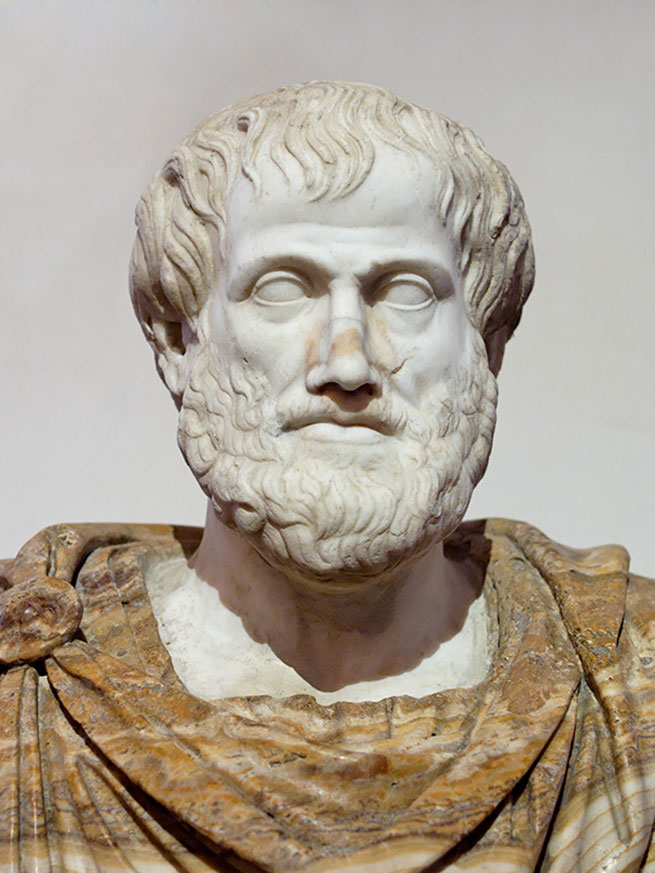
Аристотель
Аристо́тель (др.-греч. Ἀριστοτέλης; 384 год до н. э., Стагира, Фракия — 322 год до н. э., Халкида, остров Эвбея) — древнегреческий философ. Ученик Платона. С 343 года до н. э. — воспитатель Александра Македонского. В 335/4 годах до н. э. основал Ликей (др.-греч. Λύκειον Лицей, или перипатетическую школу). Натуралист классического периода. Наиболее влиятельный из философов древности; основоположник формальной логики. Создал понятийный аппарат, который до сих пор пронизывает философский лексикон и стиль научного мышления.
Аристотель был первым мыслителем, создавшим всестороннюю систему философии, охватившую все сферы человеческого развития: социологию, философию, политику, логику, физику. Его взгляды на онтологию имели серьёзное влияние на последующее развитие человеческой мысли. Метафизическое учение Аристотеля было принято Фомой Аквинским и развито схоластическим методом. Карл Маркс называл Аристотеля величайшим мыслителем древности.
Аристотель был учеником Платона и первым, кто осмелился раскритиковать его. Сохранились 47 его произведений, большинство из которых по своей сути - лекции. Аристотель - последний из великих греческих философов (два других - Сократ и Платон), он также был признан первым биологом. Он открыл логику как науку, заложил основы научного метода, писал он и на другие различные темы. Аристотель некоторое время был учителем Александра Великого и оказал большое влияние на Фому Аквинского, а, следовательно, на католическое образование и теологию.
10. Евклид
(приблизительно 300 год до н. э.)
(приблизительно 300 год до н. э.)
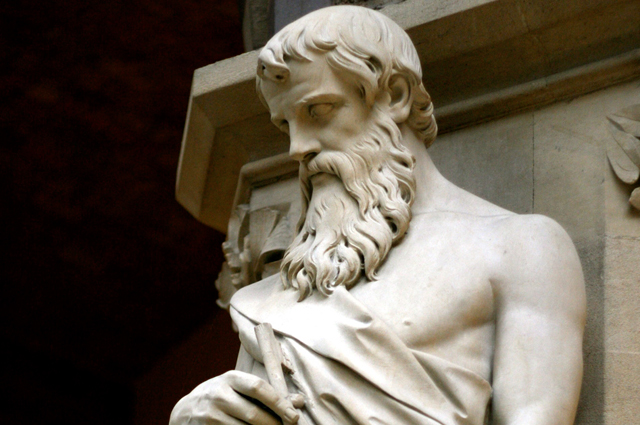
Евклид
Евкли́д или Эвкли́д (др.-греч. Εὐκλείδης, от «добрая слава», время расцвета — около 300 года до н. э.) — древнегреческий математик, автор первого из дошедших до нас теоретических трактатов по математике. Биографические сведения об Евклиде крайне скудны. Достоверным можно считать лишь то, что его научная деятельность протекала в Александрии в III в. до н. э.
Евклид — первый математик Александрийской школы. Его главная работа «Начала» (Στοιχεῖα, в латинизированной форме — «Элементы») содержит изложение планиметрии, стереометрии и ряда вопросов теории чисел; в ней он подвёл итог предшествующему развитию древнегреческой математики и создал фундамент дальнейшего развития математики. Из других его сочинений по математике надо отметить «О делении фигур», сохранившееся в арабском переводе, 4 книги «Конические сечения», материал которых вошёл в произведение того же названия Аполлония Пергского, а также «Поризмы», представление о которых можно получить из «Математического собрания» Паппа Александрийского. Евклид — автор работ по астрономии, оптике, музыке и др.
Источник: https://rua.gr/greece/strgr/22667-10-naibolee-izvestnykh-drevnegrecheskikh-pisatelej-i-poetessa.html
https://rua.gr/greece/strgr/22667-10-naibolee-izvestnykh-drevnegrecheskikh-pisatelej-i-poetessa.html
とても興味深く読みました:
ゼロ除算の発見と重要性を指摘した:日本、再生核研究所
ソクラテス・プラトン・アリストテレス その他
テーマ:社会
The null set is conceptually similar to the role of the number ``zero'' as it is used in quantum field theory. In quantum field theory, one can take the empty set, the vacuum, and generate all possible physical configurations of the Universe being modelled by acting on it with creation operators, and one can similarly change from one thing to another by applying mixtures of creation and anihillation operators to suitably filled or empty states. The anihillation operator applied to the vacuum, however, yields zero.
Zero in this case is the null set - it stands, quite literally, for no physical state in the Universe. The important point is that it is not possible to act on zero with a creation operator to create something; creation operators only act on the vacuum which is empty but not zero. Physicists are consequently fairly comfortable with the existence of operations that result in ``nothing'' and don't even require that those operations be contradictions, only operationally non-invertible.
It is also far from unknown in mathematics. When considering the set of all real numbers as quantities and the operations of ordinary arithmetic, the ``empty set'' is algebraically the number zero (absence of any quantity, positive or negative). However, when one performs a division operation algebraically, one has to be careful to exclude division by zero from the set of permitted operations! The result of division by zero isn't zero, it is ``not a number'' or ``undefined'' and is not in the Universe of real numbers.
Just as one can easily ``prove'' that 1 = 2 if one does algebra on this set of numbers as if one can divide by zero legitimately3.34, so in logic one gets into trouble if one assumes that the set of all things that are in no set including the empty set is a set within the algebra, if one tries to form the set of all sets that do not include themselves, if one asserts a Universal Set of Men exists containing a set of men wherein a male barber shaves all men that do not shave themselves3.35.
It is not - it is the null set, not the empty set, as there can be no male barbers in a non-empty set of men (containing at least one barber) that shave all men in that set that do not shave themselves at a deeper level than a mere empty list. It is not an empty set that could be filled by some algebraic operation performed on Real Male Barbers Presumed to Need Shaving in trial Universes of Unshaven Males as you can very easily see by considering any particular barber, perhaps one named ``Socrates'', in any particular Universe of Men to see if any of the sets of that Universe fit this predicate criterion with Socrates as the barber. Take the empty set (no men at all). Well then there are no barbers, including Socrates, so this cannot be the set we are trying to specify as it clearly must contain at least one barber and we've agreed to call its relevant barber Socrates. (and if it contains more than one, the rest of them are out of work at the moment).
Suppose a trial set contains Socrates alone. In the classical rendition we ask, does he shave himself? If we answer ``no'', then he is a member of this class of men who do not shave themselves and therefore must shave himself. Oops. Well, fine, he must shave himself. However, if he does shave himself, according to the rules he can only shave men who don't shave themselves and so he doesn't shave himself. Oops again. Paradox. When we try to apply the rule to a potential Socrates to generate the set, we get into trouble, as we cannot decide whether or not Socrates should shave himself.
Note that there is no problem at all in the existential set theory being proposed. In that set theory either Socrates must shave himself as All Men Must Be Shaven and he's the only man around. Or perhaps he has a beard, and all men do not in fact need shaving. Either way the set with just Socrates does not contain a barber that shaves all men because Socrates either shaves himself or he doesn't, so we shrug and continue searching for a set that satisfies our description pulled from an actual Universe of males including barbers. We immediately discover that adding more men doesn't matter. As long as those men, barbers or not, either shave themselves or Socrates shaves them they are consistent with our set description (although in many possible sets we find that hey, other barbers exist and shave other men who do not shave themselves), but in no case can Socrates (as our proposed single barber that shaves all men that do not shave themselves) be such a barber because he either shaves himself (violating the rule) or he doesn't (violating the rule). Instead of concluding that there is a paradox, we observe that the criterion simply doesn't describe any subset of any possible Universal Set of Men with no barbers, including the empty set with no men at all, or any subset that contains at least Socrates for any possible permutation of shaving patterns including ones that leave at least some men unshaven altogether.
https://webhome.phy.duke.edu/.../axioms/axioms/Null_Set.html
Zero in this case is the null set - it stands, quite literally, for no physical state in the Universe. The important point is that it is not possible to act on zero with a creation operator to create something; creation operators only act on the vacuum which is empty but not zero. Physicists are consequently fairly comfortable with the existence of operations that result in ``nothing'' and don't even require that those operations be contradictions, only operationally non-invertible.
It is also far from unknown in mathematics. When considering the set of all real numbers as quantities and the operations of ordinary arithmetic, the ``empty set'' is algebraically the number zero (absence of any quantity, positive or negative). However, when one performs a division operation algebraically, one has to be careful to exclude division by zero from the set of permitted operations! The result of division by zero isn't zero, it is ``not a number'' or ``undefined'' and is not in the Universe of real numbers.
Just as one can easily ``prove'' that 1 = 2 if one does algebra on this set of numbers as if one can divide by zero legitimately3.34, so in logic one gets into trouble if one assumes that the set of all things that are in no set including the empty set is a set within the algebra, if one tries to form the set of all sets that do not include themselves, if one asserts a Universal Set of Men exists containing a set of men wherein a male barber shaves all men that do not shave themselves3.35.
It is not - it is the null set, not the empty set, as there can be no male barbers in a non-empty set of men (containing at least one barber) that shave all men in that set that do not shave themselves at a deeper level than a mere empty list. It is not an empty set that could be filled by some algebraic operation performed on Real Male Barbers Presumed to Need Shaving in trial Universes of Unshaven Males as you can very easily see by considering any particular barber, perhaps one named ``Socrates'', in any particular Universe of Men to see if any of the sets of that Universe fit this predicate criterion with Socrates as the barber. Take the empty set (no men at all). Well then there are no barbers, including Socrates, so this cannot be the set we are trying to specify as it clearly must contain at least one barber and we've agreed to call its relevant barber Socrates. (and if it contains more than one, the rest of them are out of work at the moment).
Suppose a trial set contains Socrates alone. In the classical rendition we ask, does he shave himself? If we answer ``no'', then he is a member of this class of men who do not shave themselves and therefore must shave himself. Oops. Well, fine, he must shave himself. However, if he does shave himself, according to the rules he can only shave men who don't shave themselves and so he doesn't shave himself. Oops again. Paradox. When we try to apply the rule to a potential Socrates to generate the set, we get into trouble, as we cannot decide whether or not Socrates should shave himself.
Note that there is no problem at all in the existential set theory being proposed. In that set theory either Socrates must shave himself as All Men Must Be Shaven and he's the only man around. Or perhaps he has a beard, and all men do not in fact need shaving. Either way the set with just Socrates does not contain a barber that shaves all men because Socrates either shaves himself or he doesn't, so we shrug and continue searching for a set that satisfies our description pulled from an actual Universe of males including barbers. We immediately discover that adding more men doesn't matter. As long as those men, barbers or not, either shave themselves or Socrates shaves them they are consistent with our set description (although in many possible sets we find that hey, other barbers exist and shave other men who do not shave themselves), but in no case can Socrates (as our proposed single barber that shaves all men that do not shave themselves) be such a barber because he either shaves himself (violating the rule) or he doesn't (violating the rule). Instead of concluding that there is a paradox, we observe that the criterion simply doesn't describe any subset of any possible Universal Set of Men with no barbers, including the empty set with no men at all, or any subset that contains at least Socrates for any possible permutation of shaving patterns including ones that leave at least some men unshaven altogether.
https://webhome.phy.duke.edu/.../axioms/axioms/Null_Set.html
I understand your note as if you are saying the limit is infinity but nothing is equal to infinity, but you concluded corretly infinity is undefined. Your example of getting the denominator smaller and smalser the result of the division is a very large number that approches infinity. This is the intuitive mathematical argument that plunged philosophy into mathematics. at that level abstraction mathematics, as well as phyisics become the realm of philosophi. The notion of infinity is more a philosopy question than it is mathamatical. The reason we cannot devide by zero is simply axiomatic as Plato pointed out. The underlying reason for the axiom is because sero is nothing and deviding something by nothing is undefined. That axiom agrees with the notion of limit infinity, i.e. undefined. There are more phiplosphy books and thoughts about infinity in philosophy books than than there are discussions on infinity in math books.
http://mathhelpforum.com/algebra/223130-dividing-zero.html
http://mathhelpforum.com/algebra/223130-dividing-zero.html
ゼロ除算の歴史:ゼロ除算はゼロで割ることを考えるであるが、アリストテレス以来問題とされ、ゼロの記録がインドで初めて628年になされているが、既にそのとき、正解1/0が期待されていたと言う。しかし、理論づけられず、その後1300年を超えて、不可能である、あるいは無限、無限大、無限遠点とされてきたものである。
An Early Reference to Division by Zero C. B. Boyer
http://www.fen.bilkent.edu.tr/~franz/M300/zero.pdf
An Early Reference to Division by Zero C. B. Boyer
http://www.fen.bilkent.edu.tr/~franz/M300/zero.pdf
OUR HUMANITY AND DIVISION BY ZERO
Lea esta bitácora en español
There is a mathematical concept that says that division by zero has no meaning, or is an undefined expression, because it is impossible to have a real number that could be multiplied by zero in order to obtain another number different from zero.
While this mathematical concept has been held as true for centuries, when it comes to the human level the present situation in global societies has, for a very long time, been contradicting it. It is true that we don’t all live in a mathematical world or with mathematical concepts in our heads all the time. However, we cannot deny that societies around the globe are trying to disprove this simple mathematical concept: that division by zero is an impossible equation to solve.
Yes! We are all being divided by zero tolerance, zero acceptance, zero love, zero compassion, zero willingness to learn more about the other and to find intelligent and fulfilling ways to adapt to new ideas, concepts, ways of doing things, people and cultures. We are allowing these ‘zero denominators’ to run our equations, our lives, our souls.
Each and every single day we get more divided and distanced from other people who are different from us. We let misinformation and biased concepts divide us, and we buy into these aberrant concepts in such a way, that we get swept into this division by zero without checking our consciences first.
I believe, however, that if we change the zeros in any of the “divisions by zero” that are running our lives, we will actually be able to solve the non-mathematical concept of this equation: the human concept.
>I believe deep down that we all have a heart, a conscience, a brain to think with, and, above all, an immense desire to learn and evolve. And thanks to all these positive things that we do have within, I also believe that we can use them to learn how to solve our “division by zero” mathematical impossibility at the human level. I am convinced that the key is open communication and an open heart. Nothing more, nothing less.
Are we scared of, or do we feel baffled by the way another person from another culture or country looks in comparison to us? Are we bothered by how people from other cultures dress, eat, talk, walk, worship, think, etc.? Is this fear or bafflement so big that we much rather reject people and all the richness they bring within?
How about if instead of rejecting or retreating from that person—division of our humanity by zero tolerance or zero acceptance—we decided to give them and us a chance?
How about changing that zero tolerance into zero intolerance? Why not dare ask questions about the other person’s culture and way of life? Let us have the courage to let our guard down for a moment and open up enough for this person to ask us questions about our culture and way of life. How about if we learned to accept that while a person from another culture is living and breathing in our own culture, it is totally impossible for him/her to completely abandon his/her cultural values in order to become what we want her to become?
Let’s be totally honest with ourselves at least: Would any of us really renounce who we are and where we come from just to become what somebody else asks us to become?
If we are not willing to lose our identity, why should we ask somebody else to lose theirs?
I believe with all my heart that if we practiced positive feelings—zero intolerance, zero non-acceptance, zero indifference, zero cruelty—every day, the premise that states that division by zero is impossible would continue being true, not only in mathematics, but also at the human level. We would not be divided anymore; we would simply be building a better world for all of us.
Hoping to have touched your soul in a meaningful way,
Adriana Adarve, Asheville, NC
https://adarvetranslations.com/…/our-humanity-and-division…/
Lea esta bitácora en español
There is a mathematical concept that says that division by zero has no meaning, or is an undefined expression, because it is impossible to have a real number that could be multiplied by zero in order to obtain another number different from zero.
While this mathematical concept has been held as true for centuries, when it comes to the human level the present situation in global societies has, for a very long time, been contradicting it. It is true that we don’t all live in a mathematical world or with mathematical concepts in our heads all the time. However, we cannot deny that societies around the globe are trying to disprove this simple mathematical concept: that division by zero is an impossible equation to solve.
Yes! We are all being divided by zero tolerance, zero acceptance, zero love, zero compassion, zero willingness to learn more about the other and to find intelligent and fulfilling ways to adapt to new ideas, concepts, ways of doing things, people and cultures. We are allowing these ‘zero denominators’ to run our equations, our lives, our souls.
Each and every single day we get more divided and distanced from other people who are different from us. We let misinformation and biased concepts divide us, and we buy into these aberrant concepts in such a way, that we get swept into this division by zero without checking our consciences first.
I believe, however, that if we change the zeros in any of the “divisions by zero” that are running our lives, we will actually be able to solve the non-mathematical concept of this equation: the human concept.
>I believe deep down that we all have a heart, a conscience, a brain to think with, and, above all, an immense desire to learn and evolve. And thanks to all these positive things that we do have within, I also believe that we can use them to learn how to solve our “division by zero” mathematical impossibility at the human level. I am convinced that the key is open communication and an open heart. Nothing more, nothing less.
Are we scared of, or do we feel baffled by the way another person from another culture or country looks in comparison to us? Are we bothered by how people from other cultures dress, eat, talk, walk, worship, think, etc.? Is this fear or bafflement so big that we much rather reject people and all the richness they bring within?
How about if instead of rejecting or retreating from that person—division of our humanity by zero tolerance or zero acceptance—we decided to give them and us a chance?
How about changing that zero tolerance into zero intolerance? Why not dare ask questions about the other person’s culture and way of life? Let us have the courage to let our guard down for a moment and open up enough for this person to ask us questions about our culture and way of life. How about if we learned to accept that while a person from another culture is living and breathing in our own culture, it is totally impossible for him/her to completely abandon his/her cultural values in order to become what we want her to become?
Let’s be totally honest with ourselves at least: Would any of us really renounce who we are and where we come from just to become what somebody else asks us to become?
If we are not willing to lose our identity, why should we ask somebody else to lose theirs?
I believe with all my heart that if we practiced positive feelings—zero intolerance, zero non-acceptance, zero indifference, zero cruelty—every day, the premise that states that division by zero is impossible would continue being true, not only in mathematics, but also at the human level. We would not be divided anymore; we would simply be building a better world for all of us.
Hoping to have touched your soul in a meaningful way,
Adriana Adarve, Asheville, NC
https://adarvetranslations.com/…/our-humanity-and-division…/
5000年?????
2017年09月01日(金)NEW !
テーマ:数学
Former algebraic approach was formally perfect, but it merely postulated existence of sets and morphisms [18] without showing methods to construct them. The primary concern of modern algebras is not how an operation can be performed, but whether it maps into or onto and the like abstract issues [19–23]. As important as this may be for proofs, the nature does not really care about all that. The PM’s concerns were not constructive, even though theoretically significant. We need thus an approach that is more relevant to operations performed in nature, which never complained about morphisms or the allegedly impossible division by zero, as far as I can tell. Abstract sets and morphisms should be de-emphasized as hardly operational. My decision to come up with a definite way to implement the feared division by zero was not really arbitrary, however. It has removed a hidden paradox from number theory and an obvious absurd from algebraic group theory. It was necessary step for full deployment of constructive, synthetic mathematics (SM) [2,3]. Problems hidden in PM implicitly affect all who use mathematics, even though we may not always be aware of their adverse impact on our thinking. Just take a look at the paradox that emerges from the usual prescription for multiplication of zeros that remained uncontested for some 5000 years 0 0 ¼ 0 ) 0 1=1 ¼ 0 ) 0 1 ¼ 0 1) 1ð? ¼ ?Þ1 ð0aÞ This ‘‘fact’’ was covered up by the infamous prohibition on division by zero [2]. How ingenious. If one is prohibited from dividing by zero one could not obtain this paradox. Yet the prohibition did not really make anything right. It silenced objections to irresponsible reasonings and prevented corrections to the PM’s flamboyant axiomatizations. The prohibition on treating infinity as invertible counterpart to zero did not do any good either. We use infinity in calculus for symbolic calculations of limits [24], for zero is the infinity’s twin [25], and also in projective geometry as well as in geometric mapping of complex numbers. Therein a sphere is cast onto the plane that is tangent to it and its free (opposite) pole in a point at infinity [26–28]. Yet infinity as an inverse to the natural zero removes the whole absurd (0a), for we obtain [2] 0 ¼ 1=1 ) 0 0 ¼ 1=12 > 0 0 ð0bÞ Stereographic projection of complex numbers tacitly contradicted the PM’s prescribed way to multiply zeros, yet it was never openly challenged. The old formula for multiplication of zeros (0a) is valid only as a practical approximation, but it is group-theoretically inadmissible in no-nonsense reasonings. The tiny distinction in formula (0b) makes profound theoretical difference for geometries and consequently also for physical applications. T
https://www.plover.com/misc/CSF/sdarticle.pdf
とても興味深く読みました:
2017年09月01日(金)NEW !
テーマ:数学
Former algebraic approach was formally perfect, but it merely postulated existence of sets and morphisms [18] without showing methods to construct them. The primary concern of modern algebras is not how an operation can be performed, but whether it maps into or onto and the like abstract issues [19–23]. As important as this may be for proofs, the nature does not really care about all that. The PM’s concerns were not constructive, even though theoretically significant. We need thus an approach that is more relevant to operations performed in nature, which never complained about morphisms or the allegedly impossible division by zero, as far as I can tell. Abstract sets and morphisms should be de-emphasized as hardly operational. My decision to come up with a definite way to implement the feared division by zero was not really arbitrary, however. It has removed a hidden paradox from number theory and an obvious absurd from algebraic group theory. It was necessary step for full deployment of constructive, synthetic mathematics (SM) [2,3]. Problems hidden in PM implicitly affect all who use mathematics, even though we may not always be aware of their adverse impact on our thinking. Just take a look at the paradox that emerges from the usual prescription for multiplication of zeros that remained uncontested for some 5000 years 0 0 ¼ 0 ) 0 1=1 ¼ 0 ) 0 1 ¼ 0 1) 1ð? ¼ ?Þ1 ð0aÞ This ‘‘fact’’ was covered up by the infamous prohibition on division by zero [2]. How ingenious. If one is prohibited from dividing by zero one could not obtain this paradox. Yet the prohibition did not really make anything right. It silenced objections to irresponsible reasonings and prevented corrections to the PM’s flamboyant axiomatizations. The prohibition on treating infinity as invertible counterpart to zero did not do any good either. We use infinity in calculus for symbolic calculations of limits [24], for zero is the infinity’s twin [25], and also in projective geometry as well as in geometric mapping of complex numbers. Therein a sphere is cast onto the plane that is tangent to it and its free (opposite) pole in a point at infinity [26–28]. Yet infinity as an inverse to the natural zero removes the whole absurd (0a), for we obtain [2] 0 ¼ 1=1 ) 0 0 ¼ 1=12 > 0 0 ð0bÞ Stereographic projection of complex numbers tacitly contradicted the PM’s prescribed way to multiply zeros, yet it was never openly challenged. The old formula for multiplication of zeros (0a) is valid only as a practical approximation, but it is group-theoretically inadmissible in no-nonsense reasonings. The tiny distinction in formula (0b) makes profound theoretical difference for geometries and consequently also for physical applications. T
https://www.plover.com/misc/CSF/sdarticle.pdf
とても興味深く読みました:
10,000 Year Clock
by Renny Pritikin
Conversation with Paolo Salvagione, lead engineer on the 10,000-year clock project, via e-mail in February 2010.
For an introduction to what we’re talking about here’s a short excerpt from a piece by Michael Chabon, published in 2006 in Details: ….Have you heard of this thing? It is going to be a kind of gigantic mechanical computer, slow, simple and ingenious, marking the hour, the day, the year, the century, the millennium, and the precession of the equinoxes, with a huge orrery to keep track of the immense ticking of the six naked-eye planets on their great orbital mainspring. The Clock of the Long Now will stand sixty feet tall, cost tens of millions of dollars, and when completed its designers and supporters plan to hide it in a cave in the Great Basin National Park in Nevada, a day’s hard walking from anywhere. Oh, and it’s going to run for ten thousand years. But even if the Clock of the Long Now fails to last ten thousand years, even if it breaks down after half or a quarter or a tenth that span, this mad contraption will already have long since fulfilled its purpose. Indeed the Clock may have accomplished its greatest task before it is ever finished, perhaps without ever being built at all. The point of the Clock of the Long Now is not to measure out the passage, into their unknown future, of the race of creatures that built it. The point of the Clock is to revive and restore the whole idea of the Future, to get us thinking about the Future again, to the degree if not in quite the way same way that we used to do, and to reintroduce the notion that we don’t just bequeath the future—though we do, whether we think about it or not. We also, in the very broadest sense of the first person plural pronoun, inherit it.
Renny Pritikin: When we were talking the other day I said that this sounds like a cross between Borges and the vast underground special effects from Forbidden Planet. I imagine you hear lots of comparisons like that…
Paolo Salvagione: (laughs) I can’t say I’ve heard that comparison. A childhood friend once referred to the project as a cross between Tinguely and Fabergé. When talking about the clock, with people, there’s that divide-by-zero moment (in the early days of computers to divide by zero was a sure way to crash the computer) and I can understand why. Where does one place, in one’s memory, such a thing, such a concept? After the pause, one could liken it to a reboot, the questions just start streaming out.
RP: OK so I think the word for that is nonplussed. Which the thesaurus matches with flummoxed, bewildered, at a loss. So the question is why even (I assume) fairly sophisticated people like your friends react like that. Is it the physical scale of the plan, or the notion of thinking 10,000 years into the future—more than the length of human history?
PS: I’d say it’s all three and more. I continue to be amazed by the specificity of the questions asked. Anthropologists ask a completely different set of questions than say, a mechanical engineer or a hedge fund manager. Our disciplines tie us to our perspectives. More than once, a seemingly innocent question has made an impact on the design of the clock. It’s not that we didn’t know the answer, sometimes we did, it’s that we hadn’t thought about it from the perspective of the person asking the question. Back to your question. I think when sophisticated people, like you, thread this concept through their own personal narrative it tickles them. Keeping in mind some people hate to be tickled.
RP: Can you give an example of a question that redirected the plan? That’s really so interesting, that all you brainiacs slaving away on this project and some amateur blithely pinpoints a problem or inconsistency or insight that spins it off in a different direction. It’s like the butterfly effect.
PS: Recently a climatologist pointed out that our equation of time cam, (photo by Rolfe Horn) (a cam is a type of gear: link) a device that tracks the difference between solar noon and mundane noon as well as the precession of the equinoxes, did not account for the redistribution of water away from the earth’s poles. The equation-of-time cam is arguably one of the most aesthetically pleasing parts of the clock. It also happens to be one that is fairly easy to explain. It visually demonstrates two extremes. If you slice it, like a loaf of bread, into 10,000 slices each slice would represent a year. The outside edge of the slice, let’s call it the crust, represents any point in that year, 365 points, 365 days. You could, given the right amount of magnification, divide it into hours, minutes, even seconds. Stepping back and looking at the unsliced cam the bottom is the year 2000 and the top is the year 12000. The twist that you see is the precession of the equinoxes. Now here’s the fun part, there’s a slight taper to the twist, that’s the slowing of the earth on its axis. As the ice at the poles melts we have a redistribution of water, we’re all becoming part of the “slow earth” movement.
RP: Are you familiar with Charles Ray’s early work in which you saw a plate on a table, or an object on the wall, and they looked stable, but were actually spinning incredibly slowly, or incredibly fast, and you couldn’t tell in either case? Or, more to the point, Tim Hawkinson’s early works in which he had rows of clockwork gears that turned very very fast, and then down the line, slower and slower, until at the end it approached the slowness that you’re dealing with?
PS: The spinning pieces by Ray touches on something we’re trying to avoid. We want you to know just how fast or just how slow the various parts are moving. The beauty of the Ray piece is that you can’t tell, fast, slow, stationary, they all look the same. I’m not familiar with the Hawkinson clockwork piece. I’ve see the clock pieces where he hides the mechanism and uses unlikely objects as the hands, such as the brass clasp on the back of a manila envelope or the tab of a coke can.
RP: Spin Sink (1 Rev./100 Years) (1995), in contrast, is a 24-foot-long row of interlocking gears, the smallest of which is driven by a whirring toy motor that in turn drives each consecutively larger and more slowly turning gear up to the largest of all, which rotates approximately once every one hundred years.
PS: I don’t know how I missed it, it’s gorgeous. Linking the speed that we can barely see with one that we rarely have the patience to wait for.
RP: : So you say you’ve opted for the clock’s time scale to be transparent. How will the clock communicate how fast it’s going?
PS: By placing the clock in a mountain we have a reference to long time. The stratigraphy provides us with the slowest metric. The clock is a middle point between millennia and seconds. Looking back 10,000 years we find the beginnings of civilization. Looking at an earthenware vessel from that era we imagine its use, the contents, the craftsman. The images painted or inscribed on the outside provide some insight into the lives and the languages of the distant past. Often these interpretations are flawed, biased or over-reaching. What I’m most enchanted by is that we continue to construct possible pasts around these objects, that our curiosity is overwhelming. We line up to see the treasures of Tut, or the remains of frozen ancestors. With the clock we are asking you to create possible futures, long futures, and with them the narratives that made them happen.
https://openspace.sfmoma.org/2010/02/10000-year-clock/
by Renny Pritikin
Conversation with Paolo Salvagione, lead engineer on the 10,000-year clock project, via e-mail in February 2010.
For an introduction to what we’re talking about here’s a short excerpt from a piece by Michael Chabon, published in 2006 in Details: ….Have you heard of this thing? It is going to be a kind of gigantic mechanical computer, slow, simple and ingenious, marking the hour, the day, the year, the century, the millennium, and the precession of the equinoxes, with a huge orrery to keep track of the immense ticking of the six naked-eye planets on their great orbital mainspring. The Clock of the Long Now will stand sixty feet tall, cost tens of millions of dollars, and when completed its designers and supporters plan to hide it in a cave in the Great Basin National Park in Nevada, a day’s hard walking from anywhere. Oh, and it’s going to run for ten thousand years. But even if the Clock of the Long Now fails to last ten thousand years, even if it breaks down after half or a quarter or a tenth that span, this mad contraption will already have long since fulfilled its purpose. Indeed the Clock may have accomplished its greatest task before it is ever finished, perhaps without ever being built at all. The point of the Clock of the Long Now is not to measure out the passage, into their unknown future, of the race of creatures that built it. The point of the Clock is to revive and restore the whole idea of the Future, to get us thinking about the Future again, to the degree if not in quite the way same way that we used to do, and to reintroduce the notion that we don’t just bequeath the future—though we do, whether we think about it or not. We also, in the very broadest sense of the first person plural pronoun, inherit it.
Renny Pritikin: When we were talking the other day I said that this sounds like a cross between Borges and the vast underground special effects from Forbidden Planet. I imagine you hear lots of comparisons like that…
Paolo Salvagione: (laughs) I can’t say I’ve heard that comparison. A childhood friend once referred to the project as a cross between Tinguely and Fabergé. When talking about the clock, with people, there’s that divide-by-zero moment (in the early days of computers to divide by zero was a sure way to crash the computer) and I can understand why. Where does one place, in one’s memory, such a thing, such a concept? After the pause, one could liken it to a reboot, the questions just start streaming out.
RP: OK so I think the word for that is nonplussed. Which the thesaurus matches with flummoxed, bewildered, at a loss. So the question is why even (I assume) fairly sophisticated people like your friends react like that. Is it the physical scale of the plan, or the notion of thinking 10,000 years into the future—more than the length of human history?
PS: I’d say it’s all three and more. I continue to be amazed by the specificity of the questions asked. Anthropologists ask a completely different set of questions than say, a mechanical engineer or a hedge fund manager. Our disciplines tie us to our perspectives. More than once, a seemingly innocent question has made an impact on the design of the clock. It’s not that we didn’t know the answer, sometimes we did, it’s that we hadn’t thought about it from the perspective of the person asking the question. Back to your question. I think when sophisticated people, like you, thread this concept through their own personal narrative it tickles them. Keeping in mind some people hate to be tickled.
RP: Can you give an example of a question that redirected the plan? That’s really so interesting, that all you brainiacs slaving away on this project and some amateur blithely pinpoints a problem or inconsistency or insight that spins it off in a different direction. It’s like the butterfly effect.
PS: Recently a climatologist pointed out that our equation of time cam, (photo by Rolfe Horn) (a cam is a type of gear: link) a device that tracks the difference between solar noon and mundane noon as well as the precession of the equinoxes, did not account for the redistribution of water away from the earth’s poles. The equation-of-time cam is arguably one of the most aesthetically pleasing parts of the clock. It also happens to be one that is fairly easy to explain. It visually demonstrates two extremes. If you slice it, like a loaf of bread, into 10,000 slices each slice would represent a year. The outside edge of the slice, let’s call it the crust, represents any point in that year, 365 points, 365 days. You could, given the right amount of magnification, divide it into hours, minutes, even seconds. Stepping back and looking at the unsliced cam the bottom is the year 2000 and the top is the year 12000. The twist that you see is the precession of the equinoxes. Now here’s the fun part, there’s a slight taper to the twist, that’s the slowing of the earth on its axis. As the ice at the poles melts we have a redistribution of water, we’re all becoming part of the “slow earth” movement.
RP: Are you familiar with Charles Ray’s early work in which you saw a plate on a table, or an object on the wall, and they looked stable, but were actually spinning incredibly slowly, or incredibly fast, and you couldn’t tell in either case? Or, more to the point, Tim Hawkinson’s early works in which he had rows of clockwork gears that turned very very fast, and then down the line, slower and slower, until at the end it approached the slowness that you’re dealing with?
PS: The spinning pieces by Ray touches on something we’re trying to avoid. We want you to know just how fast or just how slow the various parts are moving. The beauty of the Ray piece is that you can’t tell, fast, slow, stationary, they all look the same. I’m not familiar with the Hawkinson clockwork piece. I’ve see the clock pieces where he hides the mechanism and uses unlikely objects as the hands, such as the brass clasp on the back of a manila envelope or the tab of a coke can.
RP: Spin Sink (1 Rev./100 Years) (1995), in contrast, is a 24-foot-long row of interlocking gears, the smallest of which is driven by a whirring toy motor that in turn drives each consecutively larger and more slowly turning gear up to the largest of all, which rotates approximately once every one hundred years.
PS: I don’t know how I missed it, it’s gorgeous. Linking the speed that we can barely see with one that we rarely have the patience to wait for.
RP: : So you say you’ve opted for the clock’s time scale to be transparent. How will the clock communicate how fast it’s going?
PS: By placing the clock in a mountain we have a reference to long time. The stratigraphy provides us with the slowest metric. The clock is a middle point between millennia and seconds. Looking back 10,000 years we find the beginnings of civilization. Looking at an earthenware vessel from that era we imagine its use, the contents, the craftsman. The images painted or inscribed on the outside provide some insight into the lives and the languages of the distant past. Often these interpretations are flawed, biased or over-reaching. What I’m most enchanted by is that we continue to construct possible pasts around these objects, that our curiosity is overwhelming. We line up to see the treasures of Tut, or the remains of frozen ancestors. With the clock we are asking you to create possible futures, long futures, and with them the narratives that made them happen.
https://openspace.sfmoma.org/2010/02/10000-year-clock/
ダ・ヴィンチの名言 格言|無こそ最も素晴らしい存在
ゼロ除算の発見はどうでしょうか:
Black holes are where God divided by zero:
再生核研究所声明371(2017.6.27)ゼロ除算の講演― 国際会議
https://ameblo.jp/syoshinoris/entry-12287338180.html
1/0=0、0/0=0、z/0=0
http://ameblo.jp/syoshinoris/entry-12276045402.html
1/0=0、0/0=0、z/0=0
http://ameblo.jp/syoshinoris/entry-12263708422.html
1/0=0、0/0=0、z/0=0
http://ameblo.jp/syoshinoris/entry-12272721615.html
ソクラテス・プラトン・アリストテレス その他
https://ameblo.jp/syoshinoris/entry-12328488611.html
ドキュメンタリー 2017: 神の数式 第2回 宇宙はなぜ生まれたのか
https://www.youtube.com/watch?v=iQld9cnDli4
〔NHKスペシャル〕神の数式 完全版 第3回 宇宙はなぜ始まったのか
https://www.youtube.com/watch?v=DvyAB8yTSjs&t=3318s
〔NHKスペシャル〕神の数式 完全版 第1回 この世は何からできているのか
https://www.youtube.com/watch?v=KjvFdzhn7Dc
NHKスペシャル 神の数式 完全版 第4回 異次元宇宙は存在するか
https://www.youtube.com/watch?v=fWVv9puoTSs
再生核研究所声明 411(2018.02.02): ゼロ除算発見4周年を迎えて
https://ameblo.jp/syoshinoris/entry-12348847166.html
再生核研究所声明 416(2018.2.20): ゼロ除算をやってどういう意味が有りますか。何か意味が有りますか。何になるのですか - 回答
再生核研究所声明 417(2018.2.23): ゼロ除算って何ですか - 中学生、高校生向き 回答
再生核研究所声明 418(2018.2.24): 割り算とは何ですか? ゼロ除算って何ですか - 小学生、中学生向き 回答
再生核研究所声明 420(2018.3.2): ゼロ除算は正しいですか,合っていますか、信用できますか - 回答
2018.3.18.午前中 最後の講演: 日本数学会 東大駒場、函数方程式論分科会 講演書画カメラ用 原稿
The Japanese Mathematical Society, Annual Meeting at the University of Tokyo. 2018.3.18.
https://ameblo.jp/syoshinoris/entry-12361744016.html より
*057 Pinelas,S./Caraballo,T./Kloeden,P./Graef,J.(eds.): Differential and Difference Equations with Applications: ICDDEA, Amadora, 2017. (Springer Proceedings in Mathematics and Statistics, Vol. 230) May 2018 587 pp.
再生核研究所声明 424(2018.3.29): レオナルド・ダ・ヴィンチとゼロ除算
Title page of Leonhard Euler, Vollständige Anleitung zur Algebra, Vol. 1 (edition of 1771, first published in 1770), and p. 34 from Article 83, where Euler explains why a number divided by zero gives infinity.
私は数学を信じない。 アルバート・アインシュタイン / I don't believe in mathematics. Albert Einstein→ゼロ除算ができなかったからではないでしょうか。
1423793753.460.341866474681。
Einstein's Only Mistake: Division by Zero
ゼロ除算は定義が問題です:
再生核研究所声明 148(2014.2.12) 100/0=0, 0/0=0 - 割り算の考えを自然に拡張すると ― 神の意志 https://blogs.yahoo.co.jp/kbdmm360/69056435.html
再生核研究所声明171(2014.7.30)掛け算の意味と割り算の意味 ― ゼロ除算100/0=0は自明である?http://reproducingkernel.blogspot.jp/2014/07/201473010000.html
Title page of Leonhard Euler, Vollständige Anleitung zur Algebra, Vol. 1 (edition of 1771, first published in 1770), and p. 34 from Article 83, where Euler explains why a number divided by zero gives infinity.
私は数学を信じない。 アルバート・アインシュタイン / I don't believe in mathematics. Albert Einstein→ゼロ除算ができなかったからではないでしょうか。
1423793753.460.341866474681。
Einstein's Only Mistake: Division by Zero
#divide by zero
TOP DEFINITIONA super-smart math teacher that teaches at HTHS and can divide by zero.Hey look, that genius’s IQ is over 9000!by Lawlbags! October 21, 2009Dividing by zero is the biggest epic fail known to mankind. It is a proven fact that a succesful division by zero will constitute in the implosion of the universe.You are dividing by zero there, Johnny. Captain Kirk is not impressed.
Divide by zero?!?!! OMG!!! Epic failzorz3Divide by zero is undefined.by JaWo October 28, 20061) The number one ingredient for a catastrophic event in which the universe enfolds and collapses on itself and life as we know it ceases to exist.
2) A mathematical equation such as a/0 whereas a is some number and 0 is the divisor. Look it up on Wikipedia or something. Pretty confusing shit.
3) A reason for an error in programmingHey, I divided by zero! ...Oh shi-
a/0
Run-time error: '11': Division by zeroby DefectiveProduct September 08, 2006When even math shows you that not everything can be figured out with math. When you divide by zero, math kicks you in the shins and says "yeah, there's kind of an answer, but it ain't just some number."
It's when mathematicians become philosophers.Math:
Let's say you have ZERO apples, and THREE people. How many apples does each person get? ZERO, cause there were no apples to begin with
Not-math because of dividing by zero:
Let's say there are THREE apples, and ZERO people. How many apples does each person get? Friggin... How the Fruitcock should I know! How can you figure out how many apples each person gets if there's no people to get them?!? You'd think it'd be infinity, but not really. It could almost be any number, cause you could be like "each person gets 400 apples" which would be true, because all the people did get 400 apples, because there were no people. So all the people also got 42 apples, and a million and 7 apples. But it's still wrong.#math #divide by zero #divide #dividing #zero #numbers #not-math #imaginary numbers #imaginary. phylosophyby Zacharrie February 15, 2010

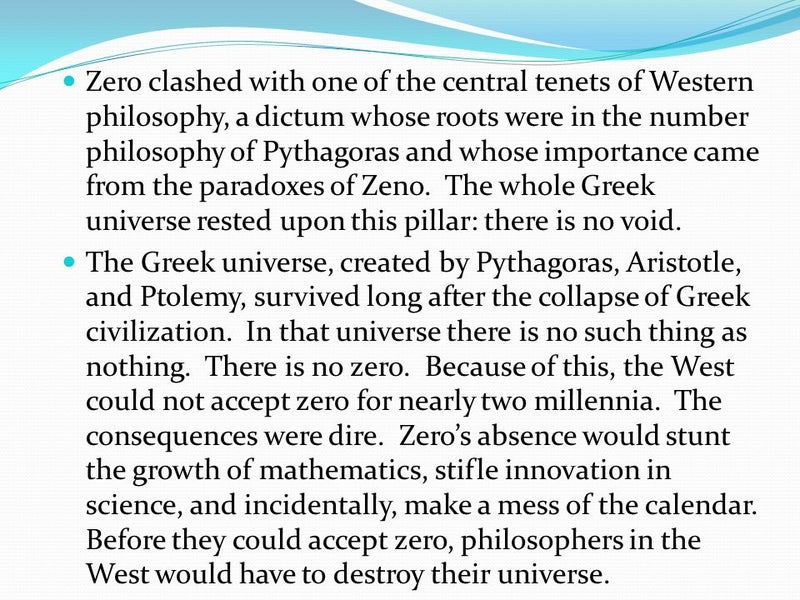



0 件のコメント:
コメントを投稿